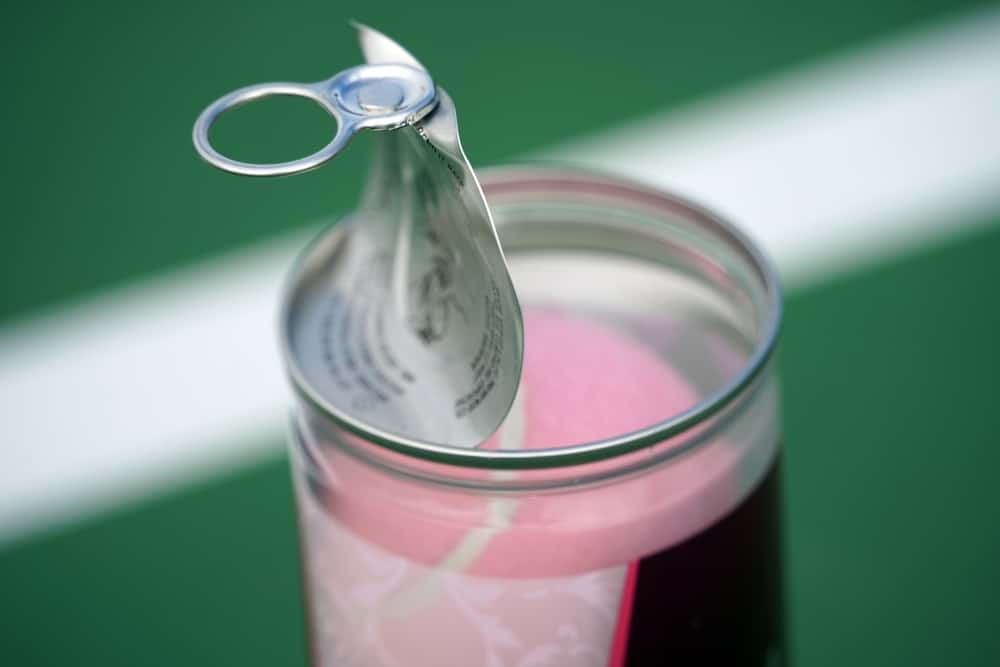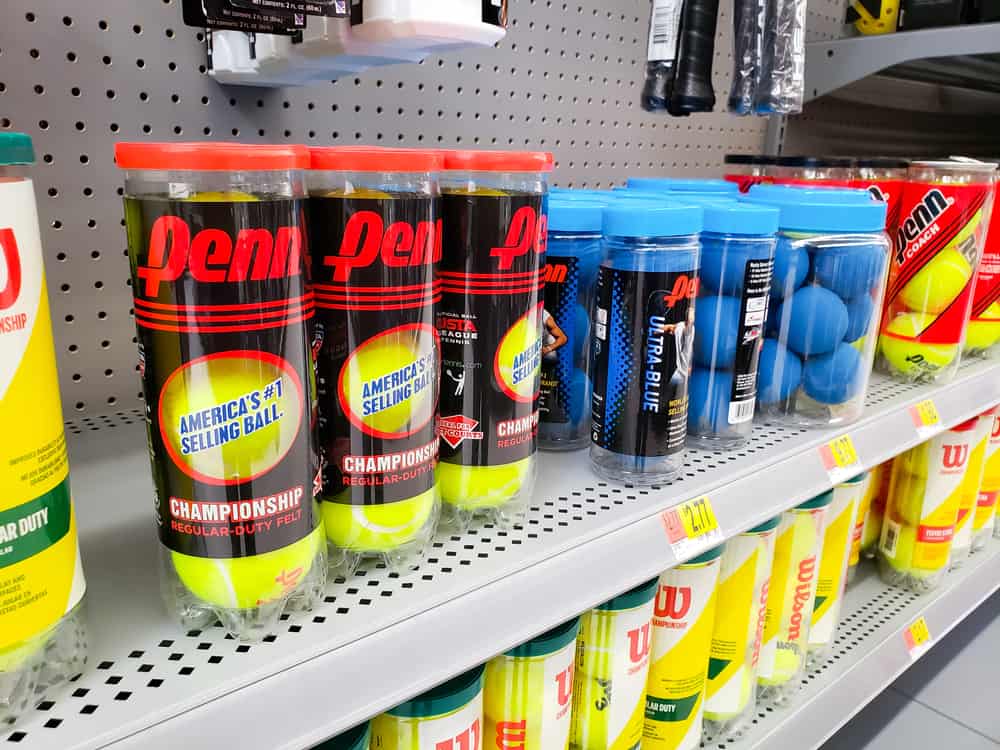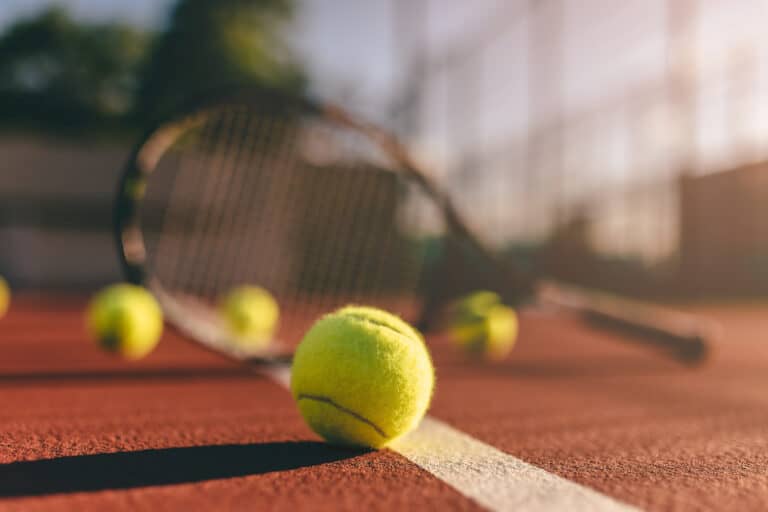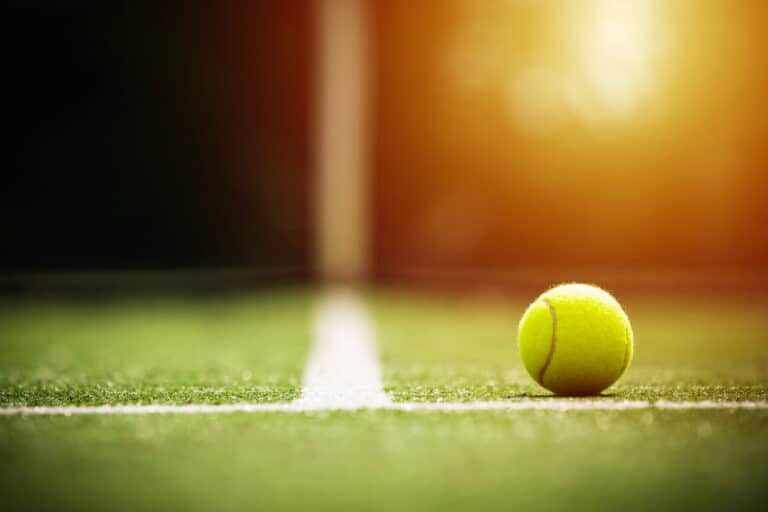Why Do They Seal Tennis Balls?
Editorial credit: The Image Party / Shutterstock.com
Opening a new can of tennis balls is almost as refreshing as opening a cold beverage on a hot day. Generally, tennis balls are sold in sealed tubes in pairs of three. But why the sealed can?
Tennis balls are sealed in a can to keep them pressurized. Tennis balls are made of rubber and have a hollow core filled with pressurized air. Over time, the pressure inside the ball dissipates, causing it to lose its bounce. Sealing the balls means they remain pressurized and bouncy for longer.
Sealing tennis balls can also help protect them from moisture and maintain their bounciness, ensuring they are ready for use once cracked open.
Why Tennis Balls Are Canned
Tennis balls are often made of natural rubber, which can be affected by humidity and temperature, so keeping them sealed in a can protects them from outside elements that could cause them to deteriorate.
Some manufacturers use nitrogen gas in the can rather than air which helps to keep the rubber fresh and preserve the bounciness for an extended period.
Furthermore, cans are easy to transport and store. It makes it convenient for people to carry multiple balls while on the go without having to worry about getting dirty, wet, or losing their pressure.
Tennis Balls Can’t Be Reinflated
All competitive tennis balls are sealed and properly pressurized.
Tennis is unique because it uses a ball filled with air once and deflates after continual use. Unlike other balls, the tennis ball cannot be re-inflated.
Two main things happen when a tennis ball is released from its sealed tube: The first is that the ball starts to absorb ambient and surrounding moisture. The next is that the ball slowly starts losing internal pressure.
When a tennis ball is exposed to moisture, the felt on the ball can become saturated, which can affect the ball’s overall performance.
The felt may become heavy and lose its bounciness, making the ball harder to hit and less fun to play with.
The moisture can also cause the ball to become heavier, which can affect the speed and trajectory of the ball when it is hit.
The cans that tennis balls are sealed in are designed to protect the ball from moisture and maintain the pressure inside the ball.
The rubber core inside the ball creates pressure inside a tennis ball. It’s made of a rubber compound that is molded into a sphere and then vulcanized, a process that involves heating the rubber to a high temperature to make it stronger and more durable.
During the vulcanization process, the rubber is subjected to high pressure, which causes the molecules in the rubber to become more tightly packed. This makes the rubber denser and more elastic, which gives the ball its bounciness.
This helps ensure that the ball performs at its best and is ready for use whenever needed.
However, sometimes the tennis ball can is squeezable despite the balls being sealed, which is a problem since there’s a leak elsewhere than the seal.
When this happens, do not open the existing seal. You won’t be able to return the balls if you do!
How Long Does Can of Tennis Balls Last?
The shelf life of a sealed can of tennis balls can vary depending on several factors, such as the type of balls, the conditions under which they are stored, and the date of manufacture.
A sealed can of tennis balls can last for several years as long as they are stored properly in a cool, dry place.
However, some manufacturers may suggest a specific shelf life, which also depends on the type of balls. Pressureless balls are made without pressurized gas and last longer than pressurized balls.
It’s also important to note that even though the balls may still be “good” in the can, their performance can degrade after a certain period. The bounciness and feel of the balls can change as the rubber starts to break down, which can affect playability.
It’s a good idea to check the can’s expiration date and consider the balls’ age if you’re buying them secondhand. If you’re unsure about the balls’ age or condition, it’s a good idea to test them before using them in a match.
How Long Does a Tennis Ball Last?
A few things can affect how long a tennis ball lasts.
For one, the type of ball is very important. Some balls are made with higher-quality materials and are more durable than others.
Additionally, balls used more frequently will naturally degrade faster than balls used less often.
The conditions in which the balls are stored can also affect how long you can use them. Tennis balls should be stored in a cool, dry place to preserve their bounciness. Exposing the ball to heat and moisture can cause the balls to degrade more quickly.
Generally, tennis balls last for several years if it is stored properly and not used excessively. However, it’s always good to check the balls’ condition before using them to ensure they are still in good condition.
Saving Money On Tennis Balls
Tennis balls are one of the few things you need to play tennis; unfortunately, they don’t always come too cheap.
However, there are a few ways to save money when buying tennis balls:
- Buy in bulk: Buying a larger quantity of tennis balls can often be less expensive than buying them in smaller quantities. Many retailers offer bulk discounts, so buying a case of balls may be cheaper than buying them individually.
- Buy pressureless balls: Pressureless balls are made without pressurized gas, which means they last longer than regular pressurized balls. They may cost more than regular balls upfront, but they can save you money in the long run because you won’t have to replace them as often.
- Look for sales and discounts: Retailers often offer sales and discounts on tennis balls at various times of the year, so keep an eye out for deals. Check out online retailers or secondhand stores; they can also be a good source of discounts.
- Join a tennis club or group: Many clubs and groups offer discounts on tennis balls for members, so it can be a good idea to look for local tennis clubs or groups in your area to see if they have any deals.
- Reusing old balls: if you play tennis infrequently or have old balls laying around and you are sure they are in playable condition, you can use them and save money on new balls.
It’s also worth noting that you can choose your brand and type of ball, not all balls are created equal, and some are more expensive than others, usually those with higher quality. It’s important to find the best balance of quality and price for you.

Get The Most Out of Your Sealed Tennis Balls
While tennis balls aren’t generally known to be a major expense, the money can quickly rack up when you want fresh tennis balls to play with.
Below are a few ways to make the most of a can of sealed tennis balls:
- Use them in rotation: Try using them to make your tennis balls last longer. This means you take one ball out of the can play with it for a set or two, and then put it back in the can and take out a fresh ball. This way, you’re not constantly hitting the same ball and wearing it down more quickly.
- Store them properly: Store your tennis balls in a cool, dry place. High temperatures and humidity can cause the rubber to break down more quickly, affecting the balls’ performance.
- Check the pressure: Before using your tennis balls, pressurize them properly. You can do this by squeezing the ball. If it feels firm, then it’s pressurized properly. If it feels soft or mushy, the pressure may be low, so the ball may not bounce.
- Train with them: When you are not playing on the court, you can use your older tennis balls for training purposes like serving practice, working on footwork and agility, or hitting with a partner.
- Share with friends: If you and your friends play tennis together, you can share a can of balls and split the cost.
- Recycle or donate old balls: If you’ve got old tennis balls that are no longer suitable for playing, they can be recycled or donated to schools, parks, or local organizations. Alternatively, pass them on to your pup!
By following these tips, you can help to make your tennis balls last longer and get the most out of your can of balls. Rather than worry about it, enjoy the game!
What Are Pressureless Tennis Balls And Their Benefits?
A pressureless tennis ball does not have any pressure inside. Unlike regular tennis balls, which are pressurized with air, pressureless balls are solid rubber balls with no air inside.
Pressureless balls are often used for practice or training because they do not lose their bounciness over time.
Since they do not have any air inside, they do not lose pressure and do not need to be re-pressurized. This makes them a more durable and long-lasting option for players who want to practice their skills.
One of the main benefits of pressureless balls is that they do not lose their bounciness over time.
Regular tennis balls can lose pressure due to age, temperature changes, and humidity, affecting their performance. Pressureless balls do not have this problem because they do not have any air inside.
Another benefit of pressureless balls is that they do not bounce as high as regular tennis balls. This can make them easier to hit and control, which is helpful for players who are just starting to learn the game or are working on their technique.
These tennis balls are a good option for players who want a durable and long-lasting ball that does not lose its bounciness over time.
They are also helpful for players looking for a ball that is easier to hit and control.
Why Tennis Balls Should Have Good Pressure
Tennis balls should have good pressure because it affects their performance on the court.
Tennis balls are made of rubber and have a hollow core filled with pressurized air. This pressurized air gives the ball its bounce and allows it to travel through the air quickly and with a good amount of spin.
When a ball is properly pressurized, it will have a consistent and predictable bounce, which is important for players to hit it accurately. A ball with good pressure will also have a consistent feel and weight, which can help with the control and accuracy of shots.
When the pressure in a ball is too low, it can cause it to have less bounce, making it more difficult to hit accurately. It also can have a softer feel, making it harder for players to generate power on their shots.
When the pressure is low, the ball can also become more affected by wind and other environmental factors, making it harder to control during play.
Good pressure on a tennis ball is essential for achieving consistent and optimal performance and can help players play at their best.
Types Of Tennis Balls
There are a few types of tennis balls available designed to suit different playing conditions and player preferences.
Below are the most common types of tennis balls:
- Outdoor vs. Indoor: Outdoor tennis balls are made with a harder rubber compound, and a thicker felt to withstand the wear and tear of playing on harder surfaces like asphalt or concrete. Indoor tennis balls have a softer rubber compound, and thinner felt, making them more suitable for playing on softer surfaces on indoor courts.
- Pressure vs. Pressureless: Pressure tennis balls are filled with pressurized air, which gives them a bouncier feel, and a consistent, predictable bounce. Pressureless tennis balls are made without pressurized air and tend to have a softer feel and a less consistent, less predictable bounce. Pressureless balls can last longer than regular balls due to not losing air pressure.
- Different brands: There are various tennis balls available, each with different characteristics; some might be more durable, some are faster, some are better for spin and control, and some might offer more visibility or have different colors.
Players may choose different types of balls based on their playing level, personal preferences, or the conditions of the courts they are playing on. A beginner player might prefer a ball that is slower and easier to control, while an advanced player might prefer a ball that is faster and offers more spin.
Ultimately, having the option of different types of tennis balls available allows players to find the ball that best suits their needs and preferences, which can help them perform at their best on the court.
Conclusion
Tennis balls are sealed in a can to preserve their quality and performance.
The canning process helps keep the balls pressurized and bouncy for a longer period; this is important because the pressurized air inside the ball gives it its bounce, and the pressure needs to be maintained for the ball to perform well.
Additionally, Tennis balls are often made of natural rubber, which can be affected by humidity and temperature, so keeping them sealed in a can protects them from outside elements that could cause them to deteriorate.
They can also protect the balls from dirt, dust, and other external factors and make them easy to transport and store.
Overall, sealing tennis balls in a can helps to keep them fresh and pressurized, which is essential for optimal performance on the court and can help players play at their best level.







